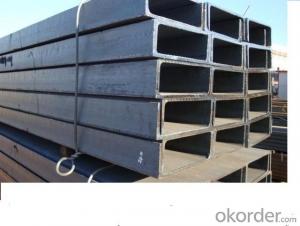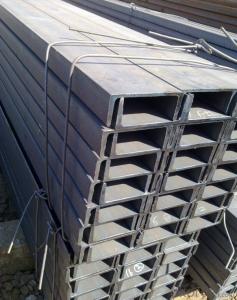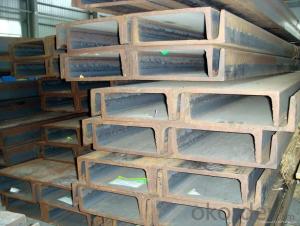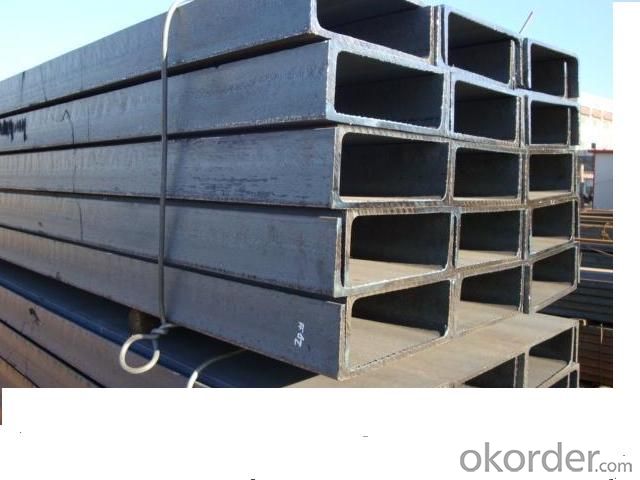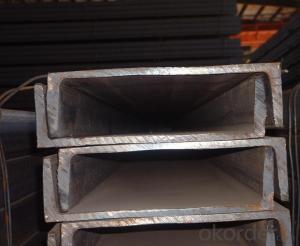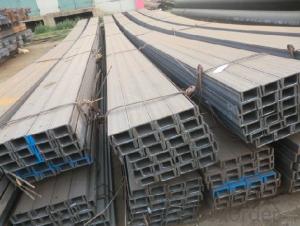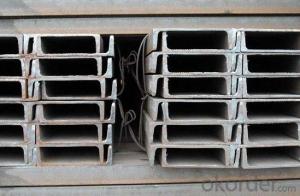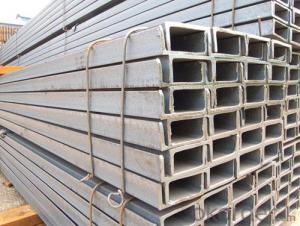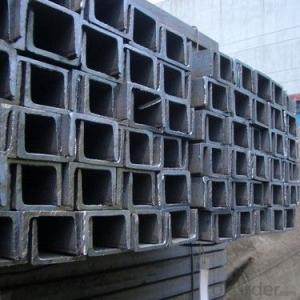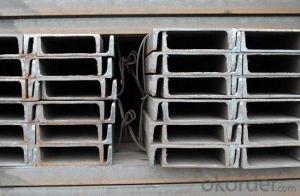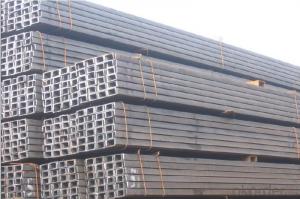GB Standard Steel Channel 300mm with High Quality
- Loading Port:
- China Main Port
- Payment Terms:
- TT or LC
- Min Order Qty:
- 25 m.t
- Supply Capability:
- 10000 m.t/month
OKorder Service Pledge
OKorder Financial Service
You Might Also Like
Product Description:
Specifications of GB Standard Steel Channel 300mm with High Quality:
1. We are definitely specializing in manufacturing and supplying channel steel.
| Standard: | GB/T 6723-86 |
| Material/Grade: | Q235 |
| Sizes: | 300mm |
| Sales Volume/Year: | 3000MT |
| Destination Area: | Middle East, Africa, Southeast Asia |
2.Size, Length and Mass.
| Size(mm) | Length(m) | Mass(Kg/m) |
| 300*85*7.5 mm | 6m, 12m | 34.463 |
| 300*87*9.5mm | 6m, 12m | 39.173 |
| 300*89*11.5mm | 6m, 12m | 43.883 |
Package & Delivery of GB Standard Steel Channel 300mm with High Quality:
The steel u channel will be packed in bundle with steel wire at each end of every bundle and color marking in order to help the customer to recognize his goods more easily at sight.
And steel u channel could be loaded into 20ft or 40ft container, or by bulk cargo. If the weight of each bundle reaches less than 3.5 mt, the loading by break bulk cargo should be choosed. When the weight of each bundle reaches less than 3mt, the loading by container should be choosed.
As for the transportaion from mill to loading port, the truck will be usually used. And the maximum quantity for each truck is 40mt.
All in all, we could do in accordance with customer's request.
FAQ:
Q1: How soon can we receive the product after purchasement?
A1: Within three days of placing an order, we will begin production. The specific shipping date is dependent upon international and government factors, but is typically one month.
Q2: How do you guarantee the quality of our products?
A2: We have established an advanced quality management system which conducts strict quality tests at every step, from raw materials to the final product. At the same time, we provide extensive follow-up service assurances as required.
Q3: The prices are invoicing on theoritical weight or on actual weight?
A3: We can do it in both manners, according to the customers' request.
Images of GB Standard Steel Channel 300mm with High Quality:
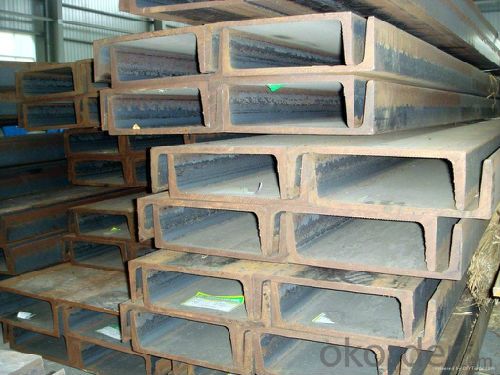
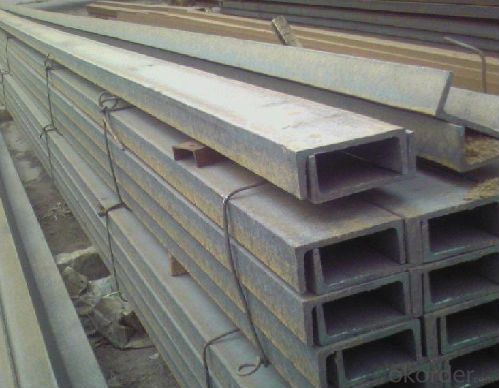
If you would like to get our price, please inform us the standard/material, size and quantity. Thank you very much.
- Q: Are steel channels suitable for use in corrosive environments?
- No, steel channels are not suitable for use in corrosive environments as they are prone to rust and corrosion.
- Q: What are the different types of steel channel connections used in industrial buildings?
- There are several types of steel channel connections used in industrial buildings. Some common examples include bolted connections, welded connections, and moment connections. Bolted connections involve using bolts and nuts to secure the channels together, while welded connections involve joining the channels through welding. Moment connections, on the other hand, are more complex and are designed to resist bending moments in the structure. These connections typically involve additional plates and welding to provide stability and strength.
- Q: What are the different fabrication techniques for steel channels?
- The industry commonly employs several fabrication techniques for steel channels. These techniques encompass a range of processes to shape, form, and assemble steel channels to meet specific requirements. Steel channels can be fabricated using various methods, including: 1. Hot Rolling: This technique is widely used and involves heating the steel above its recrystallization temperature. The heated steel is then passed through rollers to achieve the desired shape. Hot rolling ensures consistent dimensions and excellent mechanical properties. 2. Cold Forming: Precision is crucial in this technique, which involves shaping steel channels at room temperature or slightly above using pressure and bending techniques. Cold forming allows for tight tolerances and complex shapes and is often used in construction and manufacturing applications. 3. Welding: Steel channels can be joined by welding, a technique that employs heat and pressure to create a strong and durable bond between separate steel pieces. Welding methods include arc welding, gas welding, and laser welding. This technique is useful for creating customized steel channel configurations or repairing damaged channels. 4. Cutting and Machining: Excess material is removed to shape steel channels using cutting and machining techniques. Common methods include sawing, shearing, plasma cutting, waterjet cutting, and laser cutting. These techniques ensure precise dimensions, create openings, or eliminate unwanted sections from steel channels. 5. Forming and Bending: Forming and bending methods give steel channels specific shapes or curves. This can be achieved through processes like press braking, roll forming, or tube bending. Forming and bending enable the creation of custom-designed steel channels that fit specific applications or architectural requirements. 6. Surface Treatment: Surface treatment techniques enhance the corrosion resistance, aesthetic appearance, or functionality of steel channels. Common treatments include galvanizing, powder coating, painting, and applying protective coatings. These treatments provide an additional layer of protection and extend the lifespan of steel channels. In conclusion, fabrication techniques for steel channels include hot rolling, cold forming, welding, cutting and machining, forming and bending, and surface treatment. The choice of technique depends on specific project requirements, such as dimensional accuracy, strength, and surface finish.
- Q: Is the track steel often called channel or construction steel?
- See what you do, oh. Anyway, with the "beam" on the general use of I-beamChannel steel is usually made of steel structures and is matched with other types of steel
- Q: How do steel channels contribute to the overall sustainability of a structure?
- Steel channels contribute to the overall sustainability of a structure in several ways. First and foremost, steel is a highly durable and long-lasting material. It is resistant to corrosion, weathering, and degradation, which means that structures built with steel channels have a longer lifespan compared to structures made with other materials. This durability reduces the need for frequent repairs or replacements, ultimately reducing the environmental impact associated with construction and demolition waste. Additionally, steel channels are lightweight yet strong, allowing for efficient use of materials. This means that less steel is required to achieve the same structural strength, leading to reduced resource consumption and energy usage during the manufacturing process. Moreover, steel is a recyclable material, and steel channels can be easily repurposed or recycled at the end of their life cycle. Recycling steel reduces the demand for new raw materials and saves energy that would be required in the production of new steel. Furthermore, steel channels offer design flexibility and versatility, enabling architects and engineers to create innovative and sustainable structures. Steel channels can be easily shaped, welded, and assembled, facilitating the construction process and allowing for a wide range of architectural designs. This flexibility also allows for future modifications or expansions without requiring extensive demolition or reconstruction. Lastly, steel channels have excellent fire resistance properties. Steel is non-combustible and does not contribute to the spread or intensity of fires, which enhances the safety of the structure and reduces the risk to occupants and neighboring buildings. In summary, steel channels contribute to the overall sustainability of a structure through their durability, efficient use of materials, recyclability, design flexibility, and fire resistance. By choosing steel channels, we can create structures that are not only environmentally friendly but also safe, long-lasting, and cost-effective in the long run.
- Q: Can steel channels be used for roof trusses?
- Yes, steel channels can be used for roof trusses. Steel channels are often used in construction for their strength and durability. They can be manufactured to specific dimensions and can provide excellent support for roof trusses. Additionally, steel channels are resistant to warping, splitting, and shrinking, making them a reliable choice for roof trusses.
- Q: What are the different methods for joining multiple steel channels together?
- Multiple steel channels can be joined together using various methods. Below are some commonly used techniques in the industry: 1. Welding: The most prevalent and widely employed method for joining steel channels is welding. It involves melting the channel edges and fusing them together using heat. The choice of welding technique, such as arc welding, MIG welding, or TIG welding, depends on the thickness and type of steel channels. Welding ensures a strong and permanent connection. 2. Bolting: Another method is bolting, where steel channels are joined using bolts and nuts. Holes are drilled at specific intervals on the channels, and bolts are passed through these holes. Nuts are then tightened on the other side to secure the connection. Bolting is suitable for situations where future disassembly or temporary structures are anticipated. 3. Riveting: Riveting entails using metal pins called rivets to connect steel channels. Holes are drilled through the channels, and rivets are inserted into these holes. The ends of the rivets are hammered or pressed to secure them. Riveting provides a robust and stable connection, commonly used in structural applications. 4. Adhesive bonding: High-strength adhesives are used to bond steel channels together in adhesive bonding. The channels are cleaned and prepared, and adhesive is applied to one or both surfaces. The channels are then pressed together and allowed to cure. Adhesive bonding can create a strong and durable connection, but it may not be suitable for high-stress applications. 5. Mechanical fasteners: Mechanical fasteners like clips, brackets, clamps, or connectors can also be utilized to join steel channels. These fasteners are designed to provide a secure connection without the need for welding or drilling. They are frequently used when quick assembly or disassembly is necessary. When selecting the method for joining multiple steel channels, it is crucial to consider the specific requirements of your project, such as load-bearing capacity, structural integrity, and aesthetics. Consulting with a structural engineer or a professional in the field can help determine the most suitable joining method for your specific application.
- Q: How do you calculate the weight of 100 channel steel?
- If it is GB, the channel can be checked by the hardware manual sheet, and the weight is multiplied by the length of each meter, that is, its weight.
- Q: How do steel channels contribute to ventilation in structures?
- Steel channels can contribute to ventilation in structures in several ways. Firstly, steel channels can be used as part of a ventilation system to direct and distribute airflow throughout a building. These channels can be strategically placed to ensure that fresh air is brought in and stale air is removed. Additionally, steel channels can be used to support ventilation equipment such as fans, blowers, and air conditioning units. By securely mounting these devices on the channels, they can effectively circulate and distribute air throughout the structure. Furthermore, steel channels can be utilized to create air ducts within the building. These ducts can be used to transport air from one area to another, ensuring that airflow is properly distributed and reaching all areas of the structure. By using steel channels for this purpose, the ducts can be strong, durable, and resistant to damage, ensuring long-lasting and efficient ventilation. Overall, steel channels play a crucial role in the ventilation of structures as they provide the necessary support for ventilation equipment, help direct and distribute airflow, and create durable air ducts. By utilizing steel channels in ventilation systems, structures can maintain optimal air quality, temperature, and circulation, thereby creating a comfortable and healthy environment for occupants.
- Q: Can steel channels be used for balcony construction?
- Yes, steel channels can be used for balcony construction. Steel channels are versatile structural components that provide strength and stability to various construction projects, including balconies. They are commonly used as support beams or joists in balcony structures to ensure the stability and load-bearing capacity of the balcony. Steel channels have high strength-to-weight ratio, which makes them suitable for withstanding heavy loads and providing structural integrity to the balcony. Additionally, steel channels can be easily fabricated and installed, making them a popular choice for balcony construction.
Send your message to us
GB Standard Steel Channel 300mm with High Quality
- Loading Port:
- China Main Port
- Payment Terms:
- TT or LC
- Min Order Qty:
- 25 m.t
- Supply Capability:
- 10000 m.t/month
OKorder Service Pledge
OKorder Financial Service
Similar products
Hot products
Hot Searches
Related keywords
